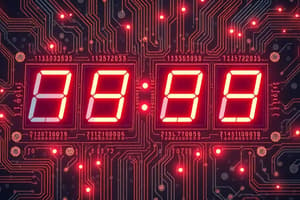Podcast
Questions and Answers
What is a primary function of timers in building automation systems?
What is a primary function of timers in building automation systems?
- To measure temperature changes in the environment
- To provide security alerts during unauthorized access
- To automatically turn devices on and off based on pre-set timings (correct)
- To detect motion within a specified area
Which type of timer is commonly preferred for its cost-effectiveness and accuracy?
Which type of timer is commonly preferred for its cost-effectiveness and accuracy?
- Mechanical timers
- Electronic timers (correct)
- Digital timers
- Hybrid timers
How do motion sensors primarily contribute to home automation systems?
How do motion sensors primarily contribute to home automation systems?
- By analyzing energy consumption of household appliances
- By controlling the temperature of the environment
- By detecting the presence of moving objects and triggering actions (correct)
- By managing communication between devices in a network
In what way can timers and sensors work together in building automation systems?
In what way can timers and sensors work together in building automation systems?
What example demonstrates the use of sensors in everyday life?
What example demonstrates the use of sensors in everyday life?
What is the primary function of a light sensor?
What is the primary function of a light sensor?
How do window sensors operate in relation to a home security system?
How do window sensors operate in relation to a home security system?
In what application are temperature sensors particularly crucial?
In what application are temperature sensors particularly crucial?
Which of the following statements about PIR sensors is accurate?
Which of the following statements about PIR sensors is accurate?
What is one benefit of using timers and sensors in energy conservation?
What is one benefit of using timers and sensors in energy conservation?
What are window sensors typically attached to?
What are window sensors typically attached to?
What electrical change occurs in a light sensor when exposed to light?
What electrical change occurs in a light sensor when exposed to light?
In which situation would a temperature sensor be essential?
In which situation would a temperature sensor be essential?
What is a commonly recognized name for light sensors?
What is a commonly recognized name for light sensors?
What role do sensors for automatic door openers play in hygiene, especially in hospitals?
What role do sensors for automatic door openers play in hygiene, especially in hospitals?
What primary purpose do electronic timers serve in building automation systems?
What primary purpose do electronic timers serve in building automation systems?
Which of the following statements accurately describes how motion sensors operate?
Which of the following statements accurately describes how motion sensors operate?
What is a significant benefit of using timers in conjunction with motion sensors?
What is a significant benefit of using timers in conjunction with motion sensors?
In what application are temperature sensors most commonly used within building automation systems?
In what application are temperature sensors most commonly used within building automation systems?
What type of automation task can be significantly improved with the integration of smart devices with built-in timers?
What type of automation task can be significantly improved with the integration of smart devices with built-in timers?
What is a characteristic feature of a temperature sensor?
What is a characteristic feature of a temperature sensor?
Which statement correctly describes the function of light sensors?
Which statement correctly describes the function of light sensors?
How do window sensors communicate with home security systems?
How do window sensors communicate with home security systems?
What role do PIR sensors primarily play?
What role do PIR sensors primarily play?
In what context are temperature sensors used to enhance safety?
In what context are temperature sensors used to enhance safety?
Which characteristic typically distinguishes light sensors from other types of sensors?
Which characteristic typically distinguishes light sensors from other types of sensors?
Which statement about window sensors is incorrect?
Which statement about window sensors is incorrect?
What is a significant benefit of using timers and sensors in energy conservation?
What is a significant benefit of using timers and sensors in energy conservation?
Which application is NOT typically associated with light sensors?
Which application is NOT typically associated with light sensors?
What is a unique feature of PIR sensors compared to other sensors?
What is a unique feature of PIR sensors compared to other sensors?
Flashcards are hidden until you start studying
Study Notes
Functions of Timers
- Timers automate the on/off operation of lighting and electrical devices based on pre-set timings, promoting energy conservation.
- Two types of timers are available: mechanical and electronic, with electronic timers being more prevalent due to being economical and accurate.
- Smart devices with built-in electronic timers are widely used in modern building automation systems.
- In shopping malls, timers manage complex lighting schedules, activating internal lights during operational hours and turning them off after closing.
- Household appliances like washing machines and microwaves utilize timers to control their operating cycles effectively.
Functions of Sensors
- Sensors function as input devices in building automation systems, providing feedback for necessary responses.
- Common examples include lift door sensors, temperature sensors for cooling systems, and smoke detectors triggering fire alarms.
- Sensors enhance convenience and safety in daily life, automatically managing various tasks based on environmental feedback.
Motion Sensors
- Motion sensors, or motion detectors, identify moving objects, especially people, within a specific detection range (5 to 30 meters).
- They can automatically control lighting systems, turning lights on when motion is detected and off when no motion is present.
- Passive infrared (PIR) sensors are commonly used for their sensitivity to the motions emitted by objects.
Light Sensors
- Light sensors, also known as photo sensors, convert light energy (visible and infrared) into electrical signals.
- They play a vital role in adjusting lighting levels and enhancing energy efficiency by responding to ambient light changes.
Temperature Sensors
- Temperature sensors detect and measure changes in temperature, crucial in environments needing temperature regulation.
- They are utilized in fire alarms to indicate sudden temperature rises and in HVAC systems to maintain desired climatic conditions while optimizing energy use.
Window Sensors
- Window sensors function in pairs: one adheres to the window and the other to the frame, detecting when the window is opened.
- They can be integrated into home security systems, sending alerts when separation occurs, thus enhancing property security.
Energy Conservation with Timers and Sensors
- Effective energy saving involves deactivating lighting and electrical devices when not in use.
- Examples include automatically opening doors without physical contact in hospitals and adjusting escalators to sleep mode during inactivity.
- Motion-detecting sensors can trigger alerts in burglar alarm systems and activate security cameras.
- Use of light sensors enables automatic adjustments of indoor light levels based on natural light availability.
- Advanced systems combine timers and sensors to manage lighting in different building areas, ensuring optimally scheduled operations.
Functions of Timers
- Timers automate the on/off operation of lighting and electrical devices based on pre-set timings, promoting energy conservation.
- Two types of timers are available: mechanical and electronic, with electronic timers being more prevalent due to being economical and accurate.
- Smart devices with built-in electronic timers are widely used in modern building automation systems.
- In shopping malls, timers manage complex lighting schedules, activating internal lights during operational hours and turning them off after closing.
- Household appliances like washing machines and microwaves utilize timers to control their operating cycles effectively.
Functions of Sensors
- Sensors function as input devices in building automation systems, providing feedback for necessary responses.
- Common examples include lift door sensors, temperature sensors for cooling systems, and smoke detectors triggering fire alarms.
- Sensors enhance convenience and safety in daily life, automatically managing various tasks based on environmental feedback.
Motion Sensors
- Motion sensors, or motion detectors, identify moving objects, especially people, within a specific detection range (5 to 30 meters).
- They can automatically control lighting systems, turning lights on when motion is detected and off when no motion is present.
- Passive infrared (PIR) sensors are commonly used for their sensitivity to the motions emitted by objects.
Light Sensors
- Light sensors, also known as photo sensors, convert light energy (visible and infrared) into electrical signals.
- They play a vital role in adjusting lighting levels and enhancing energy efficiency by responding to ambient light changes.
Temperature Sensors
- Temperature sensors detect and measure changes in temperature, crucial in environments needing temperature regulation.
- They are utilized in fire alarms to indicate sudden temperature rises and in HVAC systems to maintain desired climatic conditions while optimizing energy use.
Window Sensors
- Window sensors function in pairs: one adheres to the window and the other to the frame, detecting when the window is opened.
- They can be integrated into home security systems, sending alerts when separation occurs, thus enhancing property security.
Energy Conservation with Timers and Sensors
- Effective energy saving involves deactivating lighting and electrical devices when not in use.
- Examples include automatically opening doors without physical contact in hospitals and adjusting escalators to sleep mode during inactivity.
- Motion-detecting sensors can trigger alerts in burglar alarm systems and activate security cameras.
- Use of light sensors enables automatic adjustments of indoor light levels based on natural light availability.
- Advanced systems combine timers and sensors to manage lighting in different building areas, ensuring optimally scheduled operations.
Studying That Suits You
Use AI to generate personalized quizzes and flashcards to suit your learning preferences.




